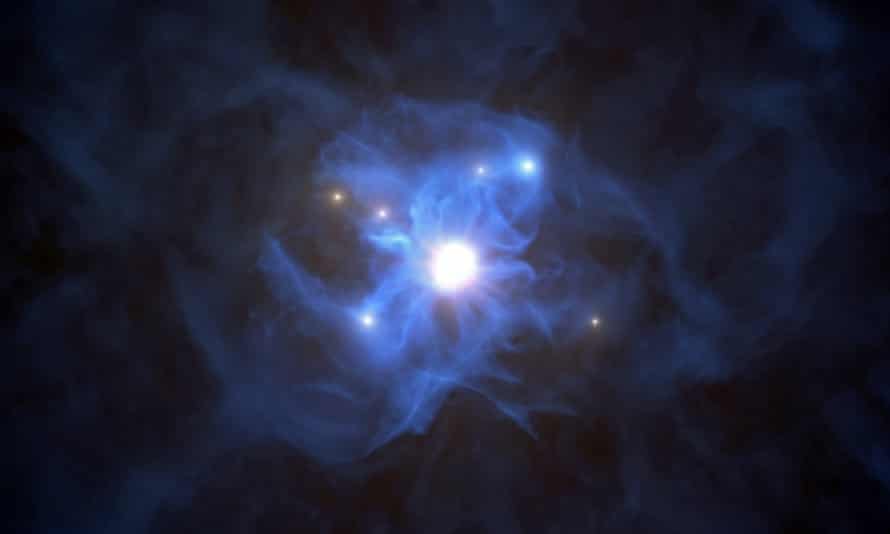Settling The Science of General Relativity
 |
| Researchers observed bright flares of X-ray emissions, produced as gas falls into a supermassive black hole. The flares echoed off of the gas falling into the black hole, and as the flares were subsiding, short flashes of X-rays were seen – corresponding to the reflection of the flares from the far side of the disk, bent around the black hole by its strong gravitational field. (Image credit: Dan Wilkins) |
"Fifty years ago, when astrophysicists started speculating about how the magnetic field might behave close to a black hole, they had no idea that one day we might have the techniques to observe this directly and see Einstein's general theory of relativity in action."Professor Roger Blandford, Luke Blossom Professor, School of Humanities and Sciences, Stanford professor of physics and SLAC professor of particle physics and astrophysics"Any light that goes into that black hole doesn’t come out, so we shouldn’t be able to see anything that’s behind the black hole.""The reason we can see that is because that black hole is warping space, bending light and twisting magnetic fields around itself.""This magnetic field getting tied up and then snapping close to the black hole heats everything around it and produces these high energy electrons that then go on to produce the X-rays.""I've been building theoretical predictions of how these echoes appear to us for a few years. I'd already seen them in the theory I've been developing, so once I saw them in the telescope observations, I could figure out the connection.""It's [Wide Field Imager detector] got a much bigger mirror than we've ever had on an X-ray telescope and it's going to let us get higher resolution looks in much shorter observation times. So, the picture we are starting to get from the data at the moment is going to become much clearer with these new observatories."Dan Wilkins, research scientist, Kavli Institute for Particle Astrophysics and Cosmology, Stanford and SLAC National Accelerator Laboratory
 |
| An artist’s impression of a supermassive black hole. Photograph: ESO/L Calçada/EPA |
Predicted in 1915, Albert Einstein's theory of general relativity has undergone many challenges to its accuracy but in the final analysis there has been no question that his theory has been upheld time and again. And now, yet again irrefutable proof of that theory has emerged with the detection of light being emitted from the back end of a black hole. His prediction was that the gravitational pull of black holes warp the fabric of space to such a degree that they twist magnetic fields and bend light.
It should be possible, he predicted, to witness the emergence of light waves as they eject from the far side of black holes resulting from the distorted magnetic fields that act as a mirror. The theory, while accepted by experts in the field, remained untested. The phenomenon was never directly observed. Now, however, given modern telescopes and the development of technologies to produce sensitive instruments, the spectacle was indeed witnessed.
The result of which is that an international team of researchers made use of X-ray telescopes in their study of a massive black hole some 800 million light years distance from Earth, located at the centre of a distant galaxy. The expected and frequently observed black hole hallmarks were seen but now researchers also were able to detect light in the form of X-rays being emitted by the far side of the black hole under scrutiny.
An astrophysicist at Stanford University, Dan Wilkins was in the process of studying the mechanics of a black hole ripping atoms and electrons apart which subsequently produces X-rays. Inspecting the accumulated data, he expected and saw X-rays spewed directly toward Earth from the black hole's core. Then he also saw shortly following this, unexpected echoes which he identified as X-rays flung out in the opposite direction to Earth, reflected by the black hole's mangled magnetic field.
That finding described in a release published in the journal Nature proved again, in supporting Einstein's theory of general relativity, how correct a theory Albert Einstein gifted to science. This celestial giant's immense gravitational pull, ingesting everything and anything in its near vicinity into its great maw was assumed to be insatiable in appetite, its interior a dense mysterious darkness emitting no light.
Now an international team of researchers, with the use of X-ray telescopes revealed that light is indeed emitted as X-rays, in the opposite direction to which the black star swallows all it surveys.
 |
| Credit: CCO Public Domain |
Labels: Albert Einstein, Astrophysicists, Black Holes, General Relativity, Light Emission, Study

0 Comments:
Post a Comment
<< Home